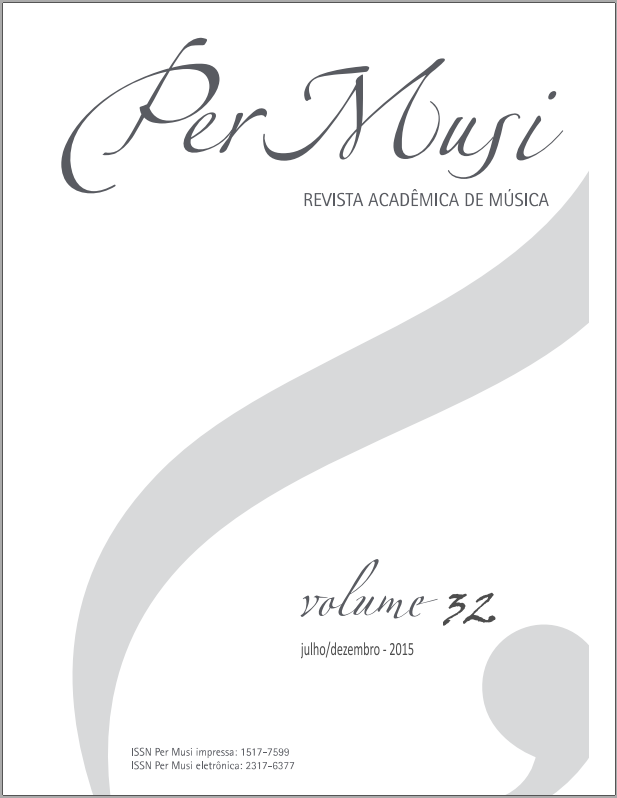Qualidade de voz no estilo de canto heavy metal
Palavras-chave:
Voz cantada no estilo heavy metal, Protocolo VPAS, Qualidade da voz cantada, Análise perceptiva do cantoResumo
Este artigo analisa a voz cantada em registros altos no estilo heavy metal com a utilização de um perfil de voz baseado na percepção (VPAS). Seu principal objetivo é fornecer um embasamento científico sobre um tema tratado subjetivamente pela literatura musical. Foram utilizados dois cantores profissionais e dois amadores na análise. Suas produções vocais foram analisadas individualmente e, posteriormente, comparadas. Juízes treinados, incluindo professores de canto, fonoaudiólogos e foneticistas, avaliaram essas amostras por meio do perfil de análise de voz VPAS. Os resultados indicam estratégias articulatórias distintas na produção de notas em registros altos nos dois grupos de cantores.
Referências
ABERCROMBIE, D. (1967). Elements of general phonetics. Edinburgh: Edinburgh University Press.
BAYER, G (2009). Heavy metal music in Britain. London: Ashgate popular and folk music series.
BEHLAU, M. (Org.). (2001). Voz. O livro do especialista. vol I. 1a ed. Rio de Janeiro: Revinter.
BEZERRA, A.; CUKIER-BLAJ, S.; DUPRAT, A.; CAMARGO, Z.; GRANATO, L. (2009). “The Characterization of the Vibrato in Lyric and Sertanejo Singing Styles: Acoustic and Perceptual Auditory Aspects”. Journal of Voice. v.23, p.666-670.
BUTTE, C; ZHANG, Y; SONG, H.; JIANG, J. (2009). “Perturbation and Nonlinear Dynamic Analysis of Different Singing Styles”. Journal of Voice. v.23, p.647-652.
CAMARGO, Z.; MADUREIRA, S. “Voice quality analysis from a phonetic perspective: Voice Profile Analysis SchemeProfile for Brazilian Portuguese (BP-VPAS)” (2008a). In: Fourth Conference on Speech Prosody - Abstract book and Proceedings. Campinas : Capes, Fapesp, CNPq. v.1, p.57-60.
_____________________________ (2008b) “Avaliação vocal sob a perspectiva fonética: análise preliminar”. Distúrbios da Comunicação. v.20(1), p.77-96.
CLEVELAND, T; SUNDBERG, J.; STONE, R. (2001). “Long-term-average spectrum characteristics of country singers during speaking and singing”. Journal of Voice. v.15, p.54-60.
CURCIO D.; BEHLAU M.S.; PONTES P.L. (2000). “Estudo da freqüência do vibrato em três estilos de canto”. In: Sociedade Brasileira de Fonoaudiologia - VII Encontro Nacional de Fonoaudiologia. Artcolor: São Paulo.
KENT, R. D.; WEISMER, G.; KENT, J.F; VORPERIAN, H.K.; DUFFY, J.R. (1999). “Acoustic studies of dysarthric speech: methods, progress, and potential”. Journal of Communication Disorders, v.32, p.141-186.
GONSALVES, A.; AMIN, E.; BEHLAU, M. (2010). “Análise do grau global e tensão da voz em cantores de roque”. Pró-Fono R. Atual. Cient. [online]. vol.22, n.3, p.195-200.
LAVER, J. (1980). The phonetic description of voice quality. Cambridge: Cambridge: Cambridge University Press.
LAVER, John. (1994). Principles of phonetics.Cambridge: Cambridge University Press.
LAVER, J. (2000). “Phonetic evaluation of voice quality”. In: Voice quality measurement”. R.D Kent, Ball M.J. (ed). San Diego: Singular Publishing, p.37-48.
LAVER, J; WIRS, S; MACKENZIE, J; HILLER, S.M. (1981). A perceptual protocol for the analysis of vocal profiles. Edinburgh; Edinburg University.Department of Linguistics; p.139-55. [Workin Progress, 14].
LAVER, J; MACKENZIE-BECK, J. (2007). Vocal Profile Analysis Scheme – VPAS. Queen Margareth University College-QMUC, Speech Science Research Centre, Edinburgh.
MACKENZIE-BECK, J. (2005). “Perceptual analysis of voice quality: the place of vocal profile analysis”. In: A figure of speech: a festschrift for John Laver. W.J. Hardcastle, J. Mackenzie-Beck (ed). Mahwah: Lawrence Erlbrum, p.285-322.
McCOY, S. (2007). “A classical pedagogue explores belting”. Journal of Singing, vol.63, p.545-49.
OLIVEIRA, L; BEHLAU, M. (2004) Perfil vocal de cantores amadores de banda de roque. [monografia]. São Paulo(SP): Centro de Estudos da Voz.
PECORARO, G; DUPRAT, A.; BANNWARTH, S.; ANDRADA e SILVA, M. (2010). “Cantores de rock: ajustes dinâmicos de trato vocal, análise perceptivoauditiva e acústica das vozes ao longo de cinco décadas”. In: Anais do 18o Congresso Brasileiro de Fonoaudiologia. Curitiba.
PINHO, S.; PONTES, P. (2002). Escala de avaliação perceptiva da fonte glótica: RASAT. Vox Brasilis. v.8(3).
POPEIL, L. S. (2007). “The multiplicity of belting”. Journal of Singing, v.64, n.1, p.77-80.
SATALOFF, R. T. (1991). Professional Voice: The Science and Art of Clinical Care. New York: Raven Press.
THALEN, M; SUNDBERG, J. (2001). “Describing different styles of singing- a comparison of a female singer’s voice source in ‘‘Classical’’, ‘‘Pop’’, ‘‘Jazz”, and ‘‘Blues”. Log Phon Vocol. v.26, p.82-93, 2001.
Downloads
Publicado
Edição
Seção
Licença
Copyright (c) 2015 Per Musi

Este trabalho está licenciado sob uma licença Creative Commons Attribution 4.0 International License.

Exceto onde está indicado, o conteúdo neste site está sob uma Licença Creative Commons - Atribuição 4.0 Internacional.












